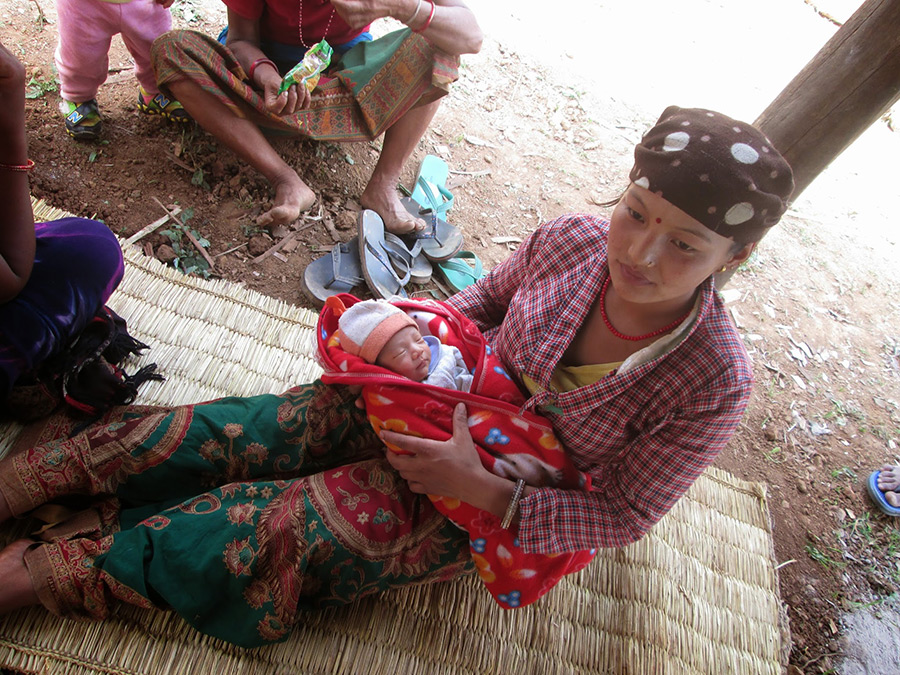WOMEN EMPOWERMENT

Chiranjibi Nepal, who is leading CARE Nepal’s programs on sexual and reproductive health, writes about the challenges of providing health care to pregnant and lactating women after the earthquake
I met Asmita (20) a few days after the earthquake had struck Nepal. She lives in a little village called Simjung in the district of Gorkha, about a nine-hours-drive from the capital of Kathmandu. Asmita’s home and most of the houses in her village have been destroyed; the stones were literally shaken apart and dispersed all over the place, burying the little belongings people possessed underneath.
Standing in front of the rubble which used to be her home, Asmita holds a little baby in her hands and smiles: “I lost my house and my belongings during the earthquake, but I also gave life to what is now most precious to me: my little baby girl.” She lifts her sari and shows me blue scars which are covering her knees. “When the earth started shaking, I was out in the village, standing on a slope. I lost balance and I fell and rolled down the hill. I was crying, out of shock and out of fear that something might have happened to my unborn child.” The next hours and days were the most difficult ones in Asmita’s life. She went back to her house to find it totally flattened. As her husband is a migrant worker in India, her mother in law took care of her. Together with nine other family members they put together a little tent they are still sharing to this day.
When Asmita went into labor, the family tried to take her to the health facility in the village next to theirs. But it was too difficult to carry her, and they did not have a stretcher. Her family rushed to find a midwife. “When I saw her coming into the tent, I felt such a relief. Thankfully, I did not have any complications,” Asmita told me and kept kissing her little baby. “When I knew that my girl was alive and healthy, I knew everything is going to be alright again. It has to. I want to raise my child in a happy environment.” To support Asmita and other women during these difficult times, CARE – with the support of UNFPA – has distributed hygiene and dignity kits, as well as reproductive health kits that include essential medicines and supplies for birthing attendants to handle medical complications in delivery.
It made me very happy to meet Asmita and her baby, but I am also very concerned. Even prior to the earthquake Nepal had one of the highest rates of maternal mortality in the world, with 170 out of 100,000 women dying during their pregnancy or birth. In the coming four weeks, 14,000 women are expected to give birth in Nepal. An estimated 2,000 of them are at risk of experiencing complications that require emergency obstetric care. They might not be as fortunate as Asmita, and giving birth for them might turn into yet another personal tragedy. The earthquake damaged or destroyed 945 health facilities. The hospitals are overcrowded with people – more than 20,000 people were injured during the earthquake. For health staff, the situation becomes increasingly difficult. I talked to Laxmi, the midwife who gave birth to Asmita’s child.
“It is very difficult for me,” Laxmi told me. “I am scared, I am tired, I have myself lost family members. My family lives in another part of Nepal and they want me to come home. Many of my colleagues are mourning and our capacities are stretched to the limits.” To support health staff like Laxmi and to support people in remote areas where health clinics have been totally destroyed, CARE is setting up clinics in the next weeks. Midwives, doctors, technicians and women’s groups will make sure to meet mothe needs of people in the hardest-hit areas; making sure they do not have to walk long distances to get the care they need. My CARE-colleagues and I will not rest until all women are smiling like Asmita.




